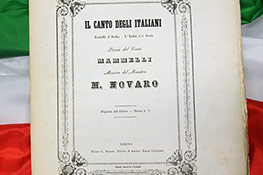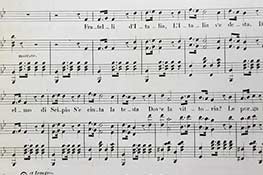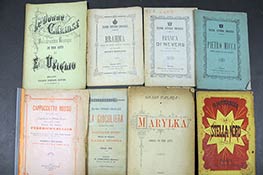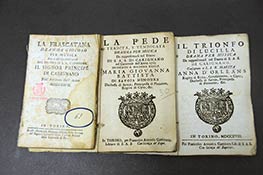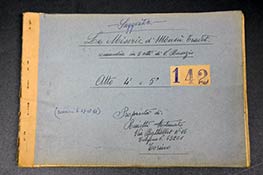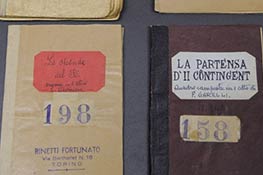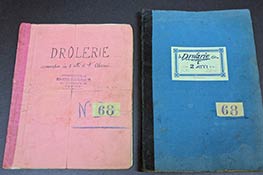Versione italiana English version Version française Versión en español
Between the collections in the "Giuseppe Grosso" historical Library there is an interesting area dedicated to the arts of singing and acting. It is a small gathering of opera librettos, ballets, sheet music and a theatrical archive made of 238 scripts of famous 800s comedies by great authors like Bersezio and Pietracqua, written in Piedmont dialect.
Sheet music
Between the sheet music preserved in the Library (255), next to chamber musics, for voice and piano, of genre and de salon, brilliant pieces and vintage arias, transcriptions from Donizetti, Bellini and Mercadante and popular songs, there is the real showpiece: the sheet of the Italian national anthem, composed by Michele Novaro on the words by Goffredo Mameli in the Lorenzo Valerio's Turin lounge in via XX Settembre, in November 1847. It is the first print madly typography Magrini between the end of '47 and the beginning of '48. On the frontispiece, within a richly decorated frame: Il canto degli Italiani/ Fratelli d'Italia - L'Italia s'è desta/ Poesia del Conte/ Mammelli/ Musica del Maestro/ M. Novaro/ Proprietà dell'Editore - Prezzo £ 2/ Torino/ Presso G. Magrini, Editore di musica, Piazza Carignano. The edition number is 1193. The last stanza is missing ("Son giunchi che piegano/ le spade vendute:/ già l'Aquila d'Austria/ le penne ha perdute") because of censorship. The high price of £ 2 is a sign that were not made many copies.
This music sheet is part of a nucleus belonging to Anselmi fund and made of about twenty homogeneous pieces, almost all edited by Magrini, characterized by a strong Risorgimento feature: next to Fratelli d'Italia there are songs and anthems dedicated to king Carlo Alberto, all created and printed between 1847 and 1848 such as: A Sua Maestà il re Carlo Alberto, Per le sagge riforme di S. M. Carlo Alberto, All'ottimo Re Carlo Alberto per le sagge riforme da Lui statuite, Inno a Carlo Alberto il dì 8 febbraio, Le Donne Subalpine a S. M. Il Re Carlo Alberto.
Between the sheets there are also 29 compositions for chant with organ accompaniment composed by Giuseppe Ponchia, a priest from Montanaro Canavese who died in 1987, keen on music and historical researches about Canavese, remembered as a talented organist.
Opera and ballet
Opera librettos owned by the historical Library are 53. Not a great number, but with the texts of famous melodramas, such as Semiramide and Linda di Chamonix by Gaetano Rossi (with Rossini's music the first and Donizetti's the second) or the Lucia di Lammermoor (text by Salvatore Cammarano and music by Donizetti) and La Sonnambula (libretto by Felice Romani and music by Vincenzo Bellini), there are interesting and typical vintage finds, "playful dramas" and ballets heroicomic-historical-allegorical that are included in the Piedmont tradition begun with Gridellino (a pale blu-grey color, typical of Italian baroque, really appreciated by the Royal Lady Maria Cristina, to whom the politic-literate-musician-coreographer Filippo d'Agliè dedicated the homonym ballet performed during the carnival of 1653).
Some titles can be used as an example: Matilde Sharon ossia bellezza e cuor di ferro, melodramma giocoso da rappresentarsi nel Teatro di S.A.S. il principe di Savoia Carignano l'autunno dell'anno 1828 (text by Jacopo Ferretti and music by Gioacchino Rossini); Le nozze de' Morlacchi, ballo eroicomico da rappresentarsi in Torino nel Teatro Carignano nella quadragesima del 1802 v.s. correndo l'anno repubblicano composto e diretto dal primo ballerino-compositore Giacomo Serafini; il trionfo della moda, ballo brillante allegorico sportivo in 5 quadri di Luigi Danesi, musica del maestro A. Andreoli (performed in Turin at Theatre Vittorio Emanuele in the Autumn of the 1899); Il Conte di Montecristo, azione mimica in 5 parti e 7 scene di Giuseppe Rota, musica del maestro Paolo Giorza.
La fede tradita e vendicata, dramma per musica da rappresentarsi nel teatro di S.A.S. di Carignano nel carnevale dell'anno 1719. Dedicato a Madama Reale Maria Giovanna Battista di Savoja Nemours duchessa di Savoja, Principessa di Piemonte, Regina di Cipro, &c is noteworthy: The music belongs to Francesco Gasparini (1668-1727), considered one of the best composero of his time, mostly active in Venice and Rome. In the end, the Libretto of a curious show: Pietro Micca: ballo storico spettacoloso in 8 quadri: composto e messo in scena al Teatro Vittorio Emanuele di Torino la stagione d'autunno1873 dal coreografo Luigi Manzotti, con musica del maestro Giovanni Chiti. The coreographer Manzotti (1835-1905) was the creator of the famous Ballo Excelsior, on the music by Romualdo Marenco, whose first staging was performed at the Scala di Milano Theatre the 11th of January 1881.
Theatrical archive
The theatre in Piedmont as it is conceived nowadays was born in 1857 with the performance of Cichin-a 'd Moncalé, readjustment of Francesca da Rimini by Pellico, staged by Giovanni Toselli (Cuneo 1819 - Genova 1886), actor and chief comedian, Garibaldian, who was the founder of the dialectical Piedmont theatre. He became really popular and many famous authors used to write for him: with his Company was staged the first representation of Miserie d'Monsu Travet by Vittorio Bersezio, the fourth of April 1863.
In its theatrical archive the historical Library preserves 238 scripts, also with manuscript sheets that refer to the separate parts of the actors. There are works by the main authors of the second half of the '800s, but also texts Belle Époque and from the first years of '900s, dramas and comedies, but even one act works, sketches, musicals, operettas and vaudeville.
Between most important authors and works: Federico Garelli (1827-1885), Toselli's coworker, and his La felicità 'd moons Guma, a Travet's variant staged close to the second independence war, in 1857. The more famous Vittorio Bersezio (1828-1900) with his Le miserie d'Monsu Travet, well known comedy, translated and performed in many languages and dialects, and about twenty other pieces, such as the last, Bastian contrari. One of the greatest authors of that period, Giovanni Zoppis (1830-1876), staged shopkeepers and employers: La papa assign al feu (1860) was really appreciated by Bersezio. By Luigi Pietracqua, printer from a poor family, a prolific author who uses a language that is closer to actual Italian instead of dialect, the Library archive preserves 24 comedies, such as Le sponde del Po, successfully staged by Toselli, the verist comedy Sablin a Bala and one of Toselli's favorites, El pover parroco.
Eraldo Baretti (1846-1895) is the author of the masterpiece I fastidi d'un grand om, staged in 1881 at the Rossini Theatre by Toselli, a comedy that was translated in many languages and dialects and like Miserie by Bersezio entered the repertoire: the action is started by the accidents and misunderstandings of Giacomo Ranella, a minister visiting hi native village. By quintino Carrera (1840-1927) is preserved I pensionari 'd monsu Neirot, great success at Alfieri Theatre in 1871, while by Mario Leoni (pseudonym of Giacomo Albertini, 1847-1931) there is 'L Bibi, his most known work, against the vice of drinking, with a realistic language, not contaminated by Italian: it was performed in 1877 and had a good success.
In the end there is the funny comedy Drolerie (1881) by Fulberto Alarni (pseudonym of Alberto Arnulfi, 1849-1888), also staged by Gipo Farassino.

